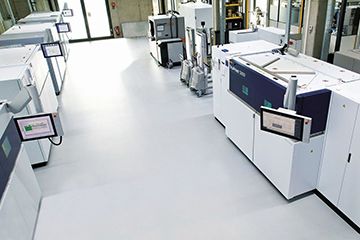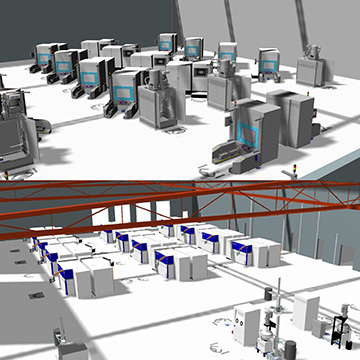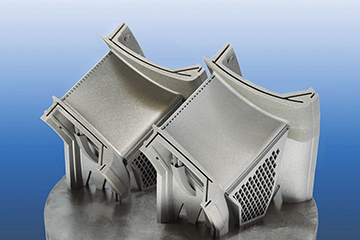
The Project IDEA additive-manufacturing production hall at Toolcraft in Georgensgmünd. [Image: © Toolcraft AG]
In November, the Project IDEA initiative—a multiyear effort involving the Fraunhofer Institute for Laser Technology (ILT), the Fraunhofer Institute for Production Technology (IPT), and a range of corporate and university partners—reported that it had successfully demonstrated how both large corporations and small- and medium-sized enterprises (SMEs) can economically leverage powder-bed-fusion laser 3D printing in real industrial settings.
The two automated additive-manufacturing pilot lines set up by the project—one a large-scale industrial line at the Siemens Energy gas turbine plant in Berlin, and the other a smaller-scale SME line at Toolcraft AG in Georgensgmünd—both logged “exemplary performance” in manufacturing high-end metal components, according to a Fraunhofer ILT press release. The project also underscored the power of “digital twins,” virtual replicas of factories that allow processes and systems to be digitally mirrored and continually fine-tuned.
A deep dive into the process chain
Wrapped up at the end of October 2022, the three-and-one-half-year Project IDEA—an acronym for “Industrialization of Digital Engineering and Additive Manufacturing”—brought together the two Fraunhofer institutes, two academic research groups at Aachen University, and 11 industrial partners including Siemens, Toolcraft, EOS, Trumpf, Jenoptik and other players. The project was funded by the German Federal Ministry of Education and Research (BMBF) as part of a larger BMBF initiative on line integration of additive-manufacturing processes.
The aim of Project IDEA was specifically to demonstrate that mass production of parts with metal 3D printing—generally viewed as an expensive process, and thus the domain only of well-heeled aerospace and medical-technology firms—could be extended to a larger number of companies with mid-range requirements. To achieve that goal, the partners began with a deep dive into the end-to-end additive-manufacturing process chain, carefully mapping out the subprocesses involved, with an eye toward substituting automated solutions for existing manual work steps.
A turbine guide vane manufactured with continuous-wave (left) and pulsed-wave (right) contour exposure. The pulsed-wave system led to enhanced detail resolution. [Image: © Fraunhofer ILT, Aachen, Germany] [Enlarge image]
One particular focus was process control. This included developing a variety of automated systems to monitor powder condition and to strengthen process qualification of multi-laser setups, as well as tuning of laser processes to enable the creation of more complex geometries with minimal post-processing. The project also integrated high-resolution stereo cameras for monitoring process instabilities.
Two pilot plants
The group then rolled the lessons learned in its initial investigation into the construction of two automated, modular production lines. The pilot line at Siemens Energy focused on laser powder-bed-fusion manufacturing of a turbine guide vane used in Siemens’ operation. The IDEA manager at Siemens, Julius Schurb, said in a press release that the pilot line’s “holistic approach” and subsequent performance demonstrated that “planned reductions in development and throughput times of around 50% can be achieved.”
Meanwhile, the Toolcraft plant aimed to show that the same economies could benefit additive manufacturing of metal parts on the much smaller scale of an SME. Toolcraft is a midsized company that specializes in tools, injection-molded parts and precision components for aerospace firms, semiconductor makers and medical technology.
Digital advantages

Planning of production lines using Siemens’ Tecnomatix 3D Plant Simulation. [Image: © Siemens Digital Industries]
In looking back on the project, Toolcraft’s Markus Langer, who heads up the funding effort for the company’s digital-transformation initiative, underscored the value of digital tools and processes in bringing automated 3D-printing processes to bear for the company. The use of VR goggles, for example, proved important “to transfer analog data … to digital work plans, to work and test instructions and interactive training,” according to Langer.
In a larger sense, the program was also seen to validate the importance of so-called digital twins, which are virtual environments that mirror production processes and allow continual process improvement.
“In the field of additive manufacturing, the digital twin is revolutionizing processes along the entire value chain,” Karsten Heuser, the vice president of additive manufacturing at Siemens Digital Industries, said in a press release. “As a virtual image of the additive component, production process or performance, it enables us to seamlessly link the individual process steps. By using the digital twin, we could consistently increase the efficiency of the two industrial lines, minimize the error rate, as well as shorten the development cycles.”

